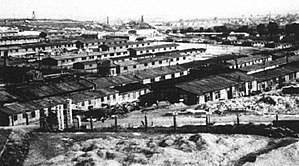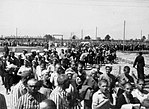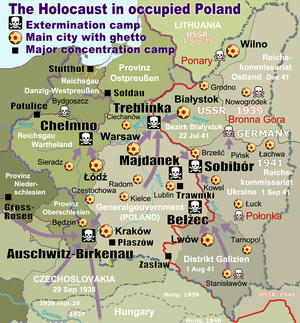
Back المعسكرات الألمانية في بولندا المحتلة خلال الحرب العالمية الثانية Arabic Campi nazisti in Polonia durante la seconda guerra mondiale Italian Campos de extermínio na Polónia ocupada durante a Segunda Guerra Mundial Portuguese
| Left to right (top to bottom): Concentration camp in Płaszów near Kraków, built by Nazi Germany in 1942 • Inmates of Birkenau returning to barracks, 1944 • Slave labour for the Generalplan Ost, making Lebensraum latifundia • Majdanek concentration camp (June 24, 1944) • Death gate at Stutthof concentration camp • Map of Nazi extermination camps in occupied Poland, marked with white skulls in black squares | |
| Operation | |
|---|---|
| Period | September 1939 – April 1945 |
| Location | Occupied Poland |
| Prisoners | |
| Total | 5 million Polish citizens (including Polish Jews and Gypsies)[1] and millions of other, mostly European, citizens |
The German camps in occupied Poland during World War II were built by the Nazis between 1939 and 1945 throughout the territory of the Polish Republic, both in the areas annexed in 1939, and in the General Government formed by Nazi Germany in the central part of the country (see map). After the 1941 German attack on the Soviet Union, a much greater system of camps was established, including the world's only industrial extermination camps constructed specifically to carry out the "Final Solution to the Jewish Question".
German-occupied Poland contained 457 camp complexes. Some of the major concentration and slave labour camps consisted of dozens of subsidiary camps scattered over a broad area. At the Gross-Rosen concentration camp, the number of subcamps was 97.[2] The Auschwitz camp complex (Auschwitz I, Auschwitz II-Birkenau, and Auschwitz III-Monowitz) had 48 satellite camps; their detailed descriptions are provided by the Auschwitz-Birkenau State Museum.[3][4] Stutthof concentration camp had 40 subcamps officially and as many as 105 subcamps in operation,[5] some as far as Elbląg, Bydgoszcz and Toruń, at a distance of 200 kilometres (120 mi) from the main camp.[6][7] The camp system was one of the key instruments of terror, while at the same time providing necessary labour for the German war economy.
The camp system was one of the key instruments of terror, while at the same time providing necessary labour for the German war economy. Historians estimate that some 5 million Polish citizens (including Polish Jews) went through them.[1] Impartial scientific research into prisoner statistics became possible only after the collapse of the Soviet Empire in 1989, because in the preceding decades all inhabitants of the eastern half of the country annexed by the USSR in 1939 were described as citizens of the Soviet Union in the official communist statistics.[1]
- ^ a b c Dr Waldemar Grabowski, IPN Centrala (31 August 2009). "Straty ludności cywilnej" [Polish civilian losses]. Straty ludzkie poniesione przez Polskę w latach 1939–1945. Bibula – pismo niezalezne. Retrieved 9 February 2016.
Według ustaleń Czesława Łuczaka, do wszelkiego rodzaju obozów odosobnienia deportowano ponad 5 mln obywateli polskich (łącznie z Żydami i Cyganami). Z liczby tej zginęło ponad 3 miliony. Translation: According to postwar research by Czesław Łuczak over 5 million Polish nationals (including Polish Jews and Roma) were deported to German camps, of whom over 3 million prisoners perished.
- ^ "Filie obozu Gross-Rosen" [Subcamps of Gross-Rosen, interactive]. Gross-Rosen Museum (Muzeum Gross Rosen w Rogoźnicy). Retrieved 15 May 2015.
- ^ List of Subcamps of KL Auschwitz (Podobozy KL Auschwitz). Archived 2011-10-12 at the Wayback Machine The Auschwitz-Birkenau State Museum in Oświęcim, Poland (Państwowe Muzeum Auschwitz-Birkenau w Oświęcimiu), 1999–2010 (in Polish)
- ^ Compiled by Dr. Stuart D. Stein (2000), "German Crimes in Poland, Central Commission for Investigation of German Crimes in Poland. Volume I, Warsaw 1946", Background and Introduction, Howard Fertig, New York, 1982, archived from the original on 2011-06-22
- ^ Cite error: The named reference
ushmm1was invoked but never defined (see the help page). - ^ "Forgotten Camps: Stutthof". JewishGen. Retrieved 15 May 2015.
- ^ "Stutthof (Sztutowo): Full Listing of Camps, Poland". Jewish Virtual Library. Retrieved 15 May 2015.
Source: "Atlas of the Holocaust" by Martin Gilbert (1982).
© MMXXIII Rich X Search. We shall prevail. All rights reserved. Rich X Search





